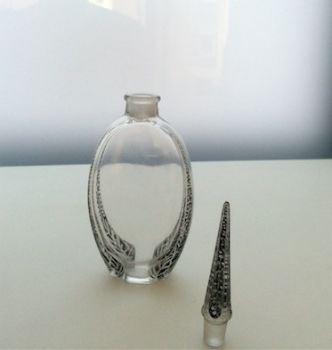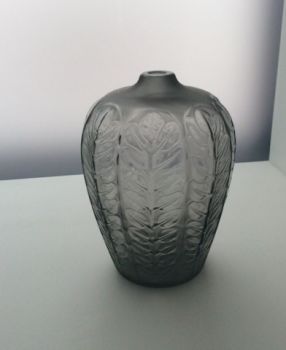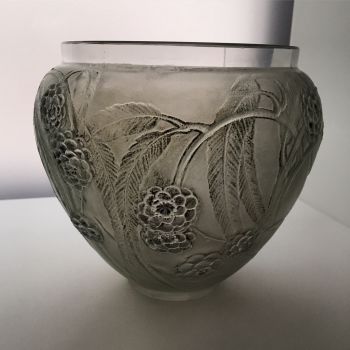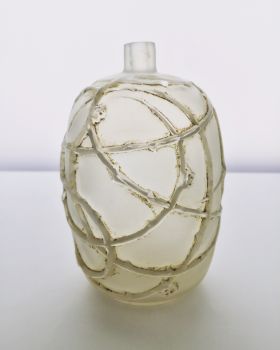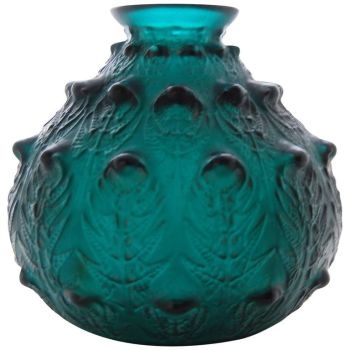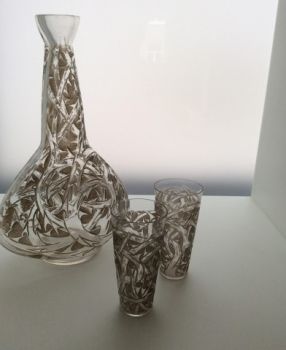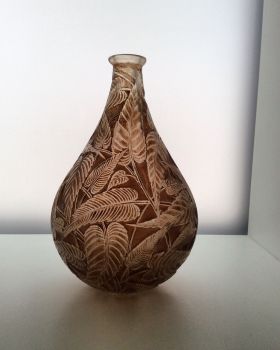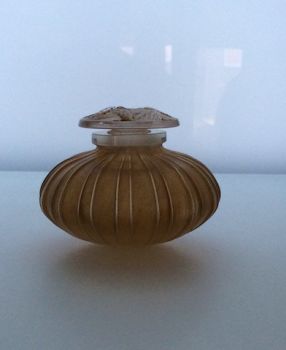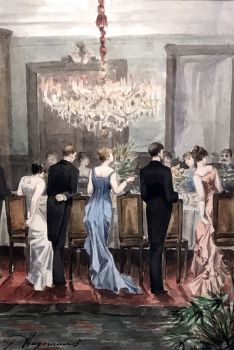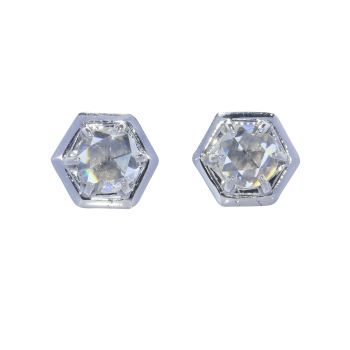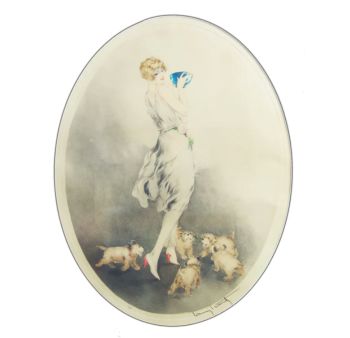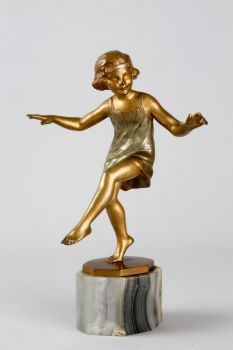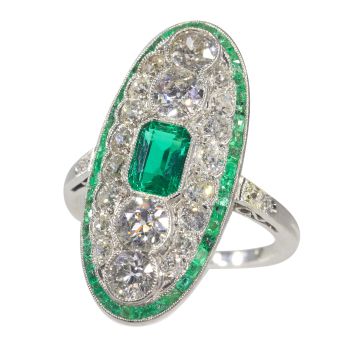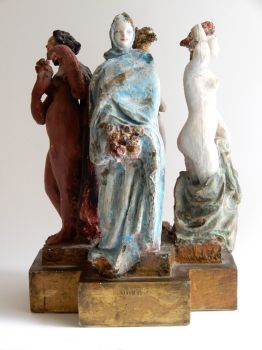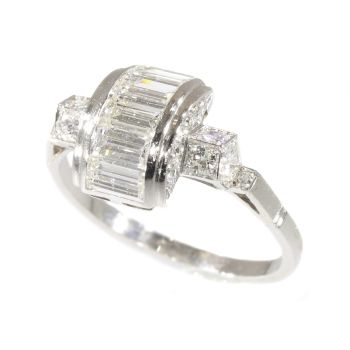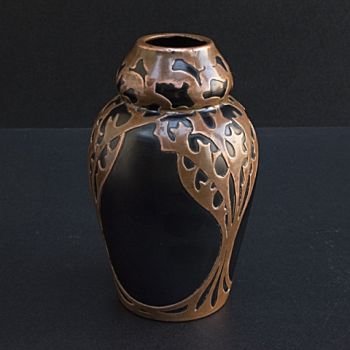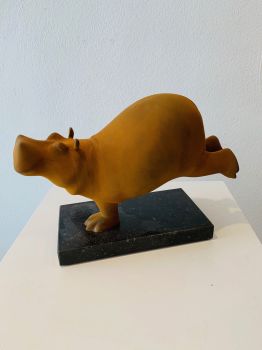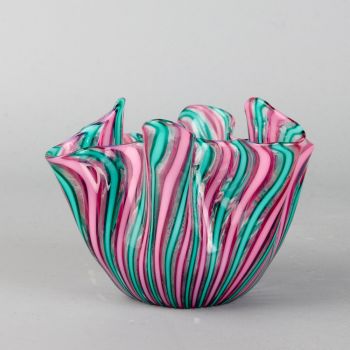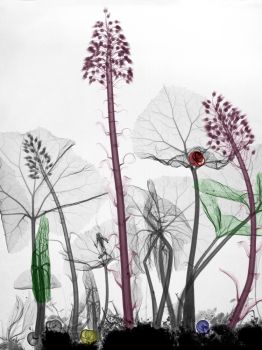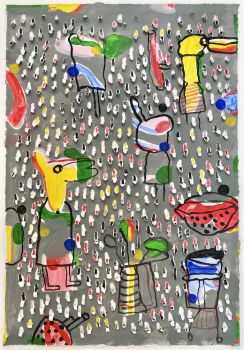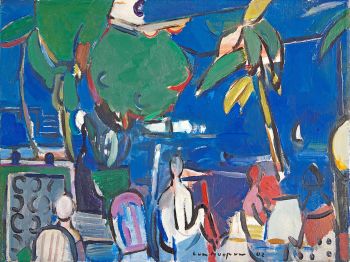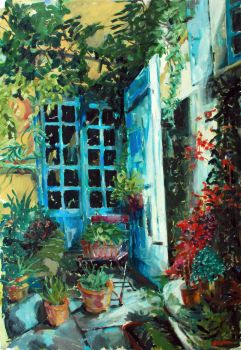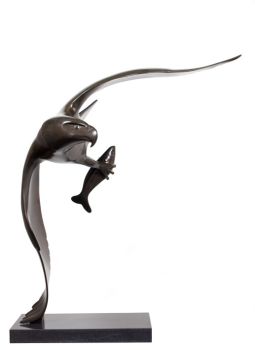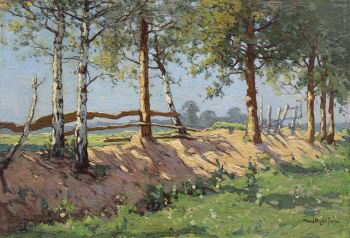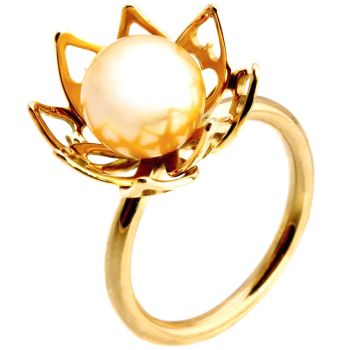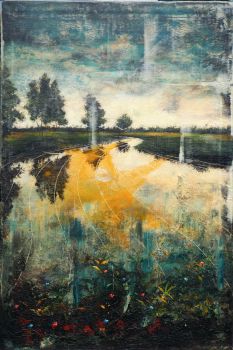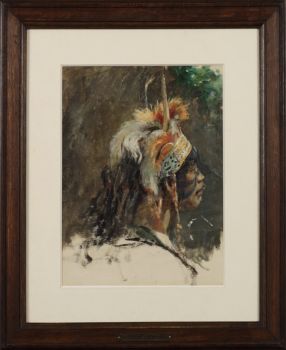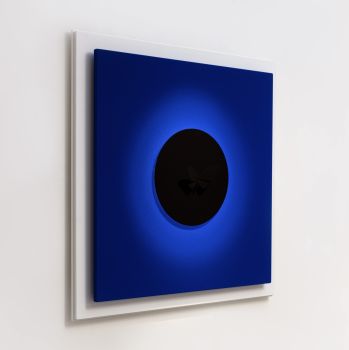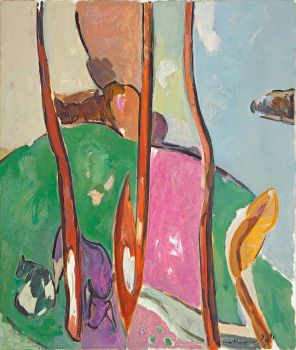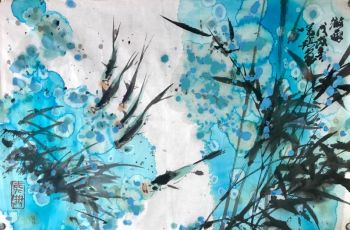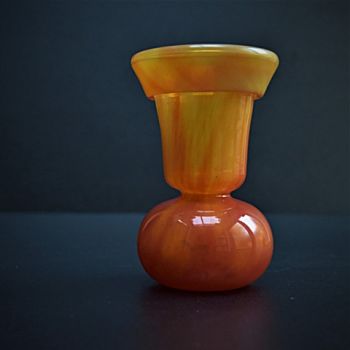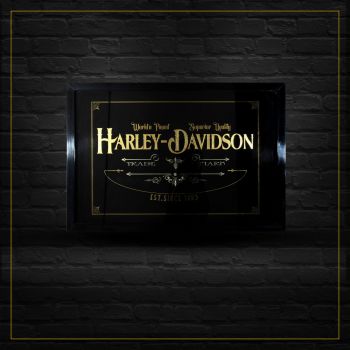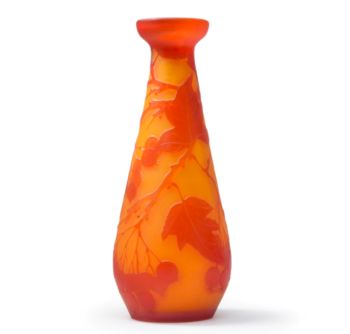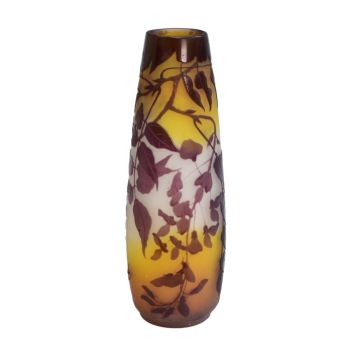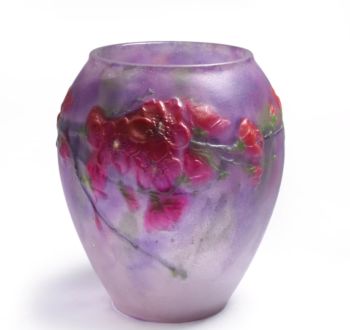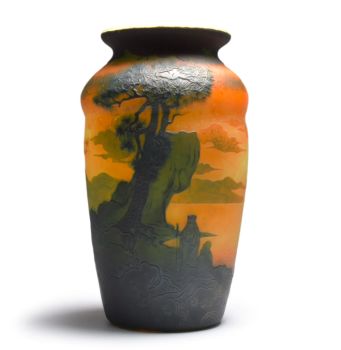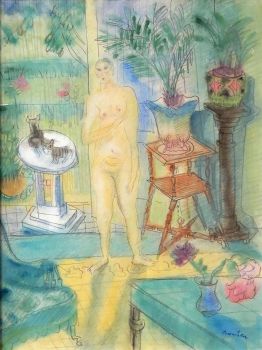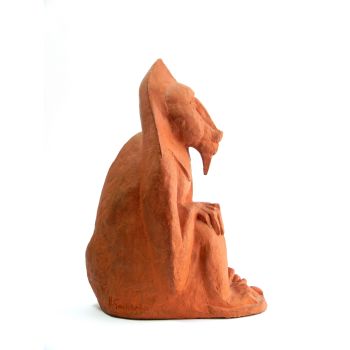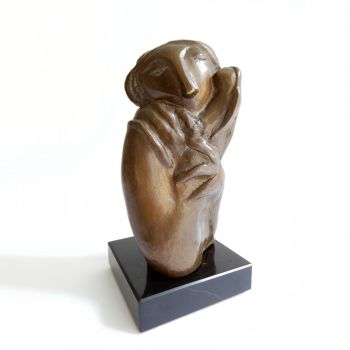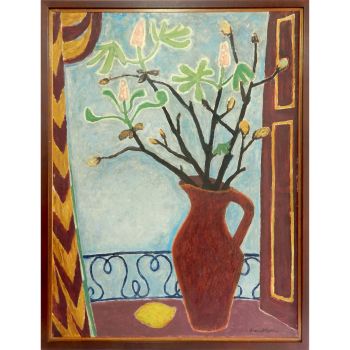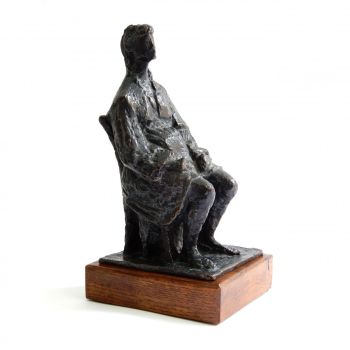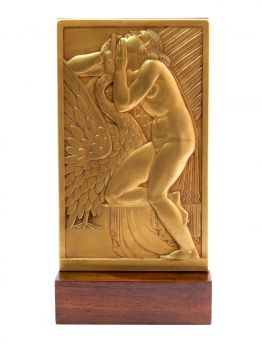Small vase 'Oléron' or 'Petits poissons' 1928 - 1932
René Lalique
Vidrio
9 cm
ConditionExcellent
Precio a consultar
Dille Art
- Sobre la obra de arteAbout this piece
Spherical vase with numerous small fish, the vase is called 'Oléron' but is also called 'Petits poissons'.
The vase is extremely refined and beautifully made, it is executed in opalescent glass. The glass consists of multiple layers of opalescent and transparent glass on top of each other, this can be clearly seen at the neck, like the rings of a tree, you see a kind of rings that differ in colour intensity, those are the different layers of glass, (cased opalescent glass), it is a difficult technique. The vase still has very light traces of a patina, so it has had a patina. Through use and especially through cleaning the vase, the infamous annual scrub, the patina has been lost almost completely. In itself, this is not a problem at all because it was an addition to the design. Lalique originally made and sold the vase with and without patina. It just depended on the preference of the buyer. To achieve opalescent glass, a special alloy is needed, everyone had their own secret recipe. René Lalique used, in addition to the usual ingredients such as silicon dioxide or sodium, arsenic, which was banned after the war, and real gold, to increase the colour intensity. Opalescent glass has the special property that it appears bluish/white when backlit, and when light shines on the vase, the glass gets an intense golden glow, as if the sun is shining on it. Very beautiful. The first photo was taken while the vase was placed in front of the window with the sun shining outside. The rather distracting background has been removed, but nothing has been done or altered to the vase itself.
The vase is blown into the mould. It is a design by René Lalique from 1927 and has model number 1008. It was listed in the catalogue of 1928 and 1932.
The vase is signed on the underside with: 'R. Lalique, France, No. 1008'. This signature is applied with the wheel (molette). This way of signing, with the addition 'France' and the model number, was only used between 1928-1932. After 1932, the model number was omitted. According to literature, this was also only done with objects that were blown into the mould, very occasionally an object was still signed in this way if the pressed signature was not clear.
At some point, in the early 1930s, René Lalique, partly due to the crisis, decided to no longer produce designs with labour-intensive finishes. This vase was also part of that decision, and it is therefore no longer mentioned in the 1937 catalogue.
The Municipal Museum of The Hague also has an opal Oléron vase in its collection. - Sobre el artistaRené Jules Lalique (6 de abril de 1860, Ay, Marne - 1 de mayo de 1945, París) nació el 6 de abril de 1860, en Ay, Marne. Fue un diseñador de vidrio francés conocido por sus creaciones de arte en vidrio, frascos de perfume, jarrones, joyas, candelabros, relojes y adornos para capós de automóviles. En 1872, cuando tenía doce años, ingresó en el Collège Turgot donde comenzó a dibujar y esbozar. Asistió a clases nocturnas en la Ecole des arts décoratifs. Trabajó allí desde 1874-1876 y posteriormente pasó dos años en la Crystal Palace School of Art Sydenham, Londres. En el Sydenham Art College, sus habilidades para el diseño gráfico mejoraron y su enfoque naturalista del arte se desarrolló aún más. Cuando regresó de Inglaterra, trabajó como artista autónomo, diseñando piezas de joyería para los joyeros franceses Cartier, Boucheron y otros. En 1885 abrió su propio negocio y diseñó y fabricó sus propias joyas y otras piezas de vidrio. En 1890, Lalique fue reconocida como una de las diseñadoras de joyas Art Nouveau más importantes de Francia; creando piezas innovadoras para la nueva tienda de Samuel Bing en París, Maison de l'Art Nouveau. Pasó a ser uno de los más famosos en su campo, su nombre es sinónimo de creatividad, belleza y calidad. Lalique era mejor conocido por sus creaciones en el arte del vidrio. En la década de 1920, se hizo conocido por su trabajo en el estilo Art Deco. Fue responsable de las paredes de vidrio iluminado y elegantes columnas de vidrio de colores que llenaban el comedor y el "gran salón" del SS Normandie y los accesorios interiores, la cruz, las mamparas, el retablo y la fuente de la iglesia de San Mateo en Millbrook en Jersey ( "Glass Church" de Lalique) .Sus experiencias anteriores en Ay fueron su influencia definitoria en su obra posterior. Como resultado, muchas de sus piezas de joyería y jarrones exhiben plantas, flores y líneas fluidas. Tanto las obras únicas como las comerciales de René Lalique se encuentran en las colecciones de un gran número de museos públicos de todo el mundo, incluido el Museu Calouste Gulbenkian en Lisboa, el Musée Lalique y el Musée des Arts Décoratifs en Francia, el Schmuckmuseum Pforzheim en Alemania, el Victoria y Albert Museum en Londres, el Metropolitan Museum y el Corning Museum en el estado de Nueva York, y el Rijksmuseum en Amsterdam. René Lalique falleció el primero de mayo de 1945 en París.
¿Está interesado en comprar esta obra de arte?
Artwork details
Categoría
Tema
Estilo
Material y Técnica
Colour
Related artworks
René Lalique
Un jarrón temprano 'Bluets' diseñado por Rene Lalique (1860-1945)1910 - 1920
Precio a consultarLennart Booij Fine Art and Rare Items
René Lalique
Un florero "Fougeres" de color verde oscuro muy raro diseñado por R. Lalique1912
€ 8.950Lennart Booij Fine Art and Rare Items
 curada por
curada porSilla Scheepens
1 - 4 / 12Gabriel Argy-Rousseau
Gabriël Argy-Rousseau – Crabes et Algues vase – 19201920 - 1929
Precio a consultarAntiques Emporium
1 - 4 / 24Gabriel Argy-Rousseau
Gabriël Argy-Rousseau – Crabes et Algues vase – 19201920 - 1929
Precio a consultarAntiques Emporium
Frères Daum
Daum Nancy – “Paysage Soleil Couchant” vase with two applied handles1900 - 1910
Precio a consultarAntiques Emporium
Amalric Walter
Amalric Walter & Henri Bergé – Crabe plumier1920 - 1929
Precio a consultarAntiques Emporium
Demetre Chiparus
Demetre H. Chiparus – Bronze Art Deco statue “Rapture” – Édition Etling, Paris1920 - 1929
Precio a consultarAntiques Emporium
1 - 4 / 24- 1 - 4 / 24
Artista Desconocido
EIGHT NEO-GOTHIC STAINED GLASS WINDOWS WITH SUSPENSION EYELET, 19th C, BELGIUM.1850 - 1900
Precio a consultarSpectandum Gallery
Amalric Walter
Amalric Walter & Henri Bergé – Crabe plumier1920 - 1929
Precio a consultarAntiques Emporium
1 - 4 / 24Artista Desconocido
Japanese art deco lacquervase with Scarab beetle motif1920 - 1950
Precio a consultarDille Art
1 - 4 / 12






